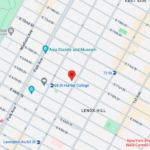Living with bunion pain shouldn’t limit your daily activities. At New York Bone & Joint Specialists, our experienced podiatrists and orthopedic surgeons provide comprehensive bunion treatment, from conservative care to advanced surgical solutions.
If you have a bunion, every step you take can cause excruciating pain. Every time you stand or put pressure on your big toe, the discomfort worsens. Finding comfortable shoes becomes nearly impossible, affecting your quality of life.
Because bunions are such a common foot problem, effective treatment is readily available. New York Bone & Joint Specialists is one of the premier destinations in NYC for bunion care. Our specialists will develop a personalized treatment plan to eliminate your foot pain and restore pain-free mobility. When conservative methods don’t provide adequate relief, you’ll be in expert hands with our skilled bunion surgery physicians.
What Are Bunions? Understanding the Condition
A bunion develops as a bony outgrowth at the base of the metatarsophalangeal joint, which connects the big toe to the rest of the foot. Known medically as hallux valgus, a bunion appears as a noticeable bump on the side of the big toe, involving changes to both bone structure and surrounding soft tissues.
Bunions are progressive conditions that advance slowly as increasing pressure is placed on the big toe. Eventually, the bunion grows to the point where the joint appears deformed and slants inward toward the adjacent toe. As the condition progresses, you’ll experience increasing foot pain, stiffness, and swelling, which may make walking progressively more difficult.
About one-third of all adults in the U.S. will develop a bunion at some point in their lives, with prevalence increasing significantly with age. The condition affects women more frequently than men due to anatomical differences, genetic factors, and footwear choices.
While the big toe is the most common site for bunion formation, they can also develop at the base of the pinky toe—a condition called a tailor’s bunion or bunionette. Tailor’s bunions typically result from ill-fitting shoes or excessive pressure on the little toe that pushes it toward adjacent toes.
Bunion Symptoms and Stages
Bunion symptoms develop gradually over time. You’ll likely experience these signs as the condition progresses:
- Visible bony growth along the outside of the big toe that may increase in size and cause the toe to cross over toward the second toe
- Pain or stiffness in the big toe joint, especially during movement
- Swelling, discoloration, and redness in the area around the bony prominence
- Limited range of motion – inability to bend the big toe normally, or experiencing a burning sensation when attempting to move the joint
- Footwear difficulties – increasing trouble wearing certain types of shoes comfortably
- Activity-related pain that worsens when wearing shoes or during extended periods of standing or walking
If left untreated, bunions may lead to secondary foot problems, including:
- Hammertoes: Bunion pressure on nearby toes causes tendons and muscles to tighten, creating a curled or bent toe position
- Corns or calluses: Friction between the bunion area and adjacent toes causes skin thickening and pain
- Numbness: Nerve compression can cause decreased sensation around the big toe
- Bursitis: Painful, fluid-filled sacs may develop in the affected joint
- Metatarsalgia: Pain and inflammation in the ball of the foot
Bunions don’t resolve on their own and typically worsen over time. If bunion pain intensifies and interferes with your daily activities or ability to walk comfortably, consult with a bunion specialist to discuss appropriate treatment options.
What Causes Bunions to Develop?
The exact cause of bunions isn’t completely understood, but the condition typically results from multiple contributing factors:
- Genetics: Approximately 70% of patients with bunions have a parent with the same condition. Some people inherit foot structures or joint abnormalities that predispose them to bunion development.
- Footwear: While tight shoes with narrow toe boxes or high heels don’t directly cause bunions, such footwear can significantly increase pain and accelerate the progression of existing bunions.
- Biomechanical issues: Flat feet, overpronation (excessive inward rolling of the foot during walking or running), and other gait abnormalities can contribute to bunion formation.
- Medical conditions: Inflammatory diseases such as rheumatoid arthritis, lupus, and osteoarthritis increase bunion risk.
- Previous injuries: Athletes with a history of foot or toe injuries may be more susceptible to bunion development.
- Demographics: Women experience bunions more frequently than men, and the condition becomes more common with advancing age.
- Occupational factors: People who stand for prolonged periods, such as factory workers, teachers, healthcare workers, and retail employees, have increased bunion risk.
“While bunions may seem like just a cosmetic concern, they can significantly impact your mobility and quality of life if left untreated. Our expert team offers both conservative management and advanced surgical techniques to realign your foot structure and eliminate pain.” – Dr. Leon Popovitz, MD, New York Bone & Joint Co-Founder.
Bunion Prevention Strategies
While bunions may not be entirely preventable if you have a genetic predisposition, you can take proactive steps to reduce your risk or slow progression:
- Choose appropriate footwear: Avoid shoes with restricted toe boxes or excessively high heels that squeeze the toes together
- Perform foot exercises: Regular toe curls, marble pickups with your toes, and stretching exercises can help maintain foot flexibility and strength
- Maintain healthy weight: Reducing excess weight decreases pressure on your feet and may slow bunion progression
- Seek early intervention: See a foot specialist at the first signs of a bump or persistent foot pain
- Schedule regular checkups: Make routine appointments with a podiatrist or orthopedic foot specialist for preventive care
- Take breaks from standing: If your job requires prolonged standing on hard surfaces, take regular breaks to sit and relieve foot pressure
- Use supportive insoles: Custom or over-the-counter arch supports can help maintain proper foot alignment
Bunion Correctors and Non-Surgical Treatment Options
If you don’t want to go the surgical route, these conservative methods and bunion correctors can alleviate foot pain and make walking more comfortable:
- Bunion pads. Available in stores in different sizes and shapes. Made of fabric or gel, the pads shield the bunion from rubbing against your shoe.
- Splints. Worn at night, a splint can keep the toe straight and ease pain.
- Orthotic inserts. Custom-made or off-the shelf, orthotic inserts redistribute your weight evenly across the foot bones and joints to alleviate pain and pressure on the big toe.
- Anti-inflammatory medications. Over-the-counter nonsteroidal anti-inflammatory drugs (naproxen, ibuprofen aspirin) for pain management.
- Toe spacers. Toe spacers keep the toes in proper alignment and lessen pressure on the big toe.
- Physical therapy. To strengthen and improve flexibility in the toe, you can do toe curls and big toe stretches.
- Lifestyle changes. Avoid any activity that puts excessive weight on the affected foot.
Pain from mild cases of bunions typically resolve with conservative treatment. But such methods only treat the symptoms, not the root cause, which is the bunion itself.
Surgery is reserved for an underlying deformity that can only be corrected with surgery or if non-surgical methods fail to stop pain. Surgery is not recommended for cosmetic reasons to eliminate a painless bump at the side of your big toe.
When is Bunion Surgery Necessary?
Bunion surgery may be recommended when:
- You experience persistent, severe pain that doesn’t respond to conservative treatments after 6-12 months
- The bunion deformity significantly affects adjacent toes or overall foot function
- You can no longer participate in normal daily activities, work duties, or exercise
- The bunion causes recurrent infections or skin breakdown
- Conservative treatments have failed to provide adequate pain relief
Before recommending surgery, your surgeon will carefully evaluate several factors:
- Severity of the bunion deformity and associated arthritis
- Your overall health status and ability to heal properly
- Presence of conditions like diabetes, vascular disease, or immune disorders that may affect healing
- Your activity level, occupation, and treatment goals
- Previous response to non-surgical treatments
Important note: Bunion surgery should never be performed solely for cosmetic reasons on a painless bunion, as all surgical procedures carry inherent risks.
Types of Bunion Surgery Procedures
Depending on bunion severity and individual factors, several surgical approaches may be appropriate:
Traditional Bunionectomy
- Performed under local anesthesia with sedation, the surgeon makes an incision over the bunion and removes the bony prominence. Tight soft tissues pulling the toe out of alignment may also be released. Patients typically go home the same day wearing a protective cast or boot for 4-6 weeks.
Minimally Invasive Bunion Surgery
- These newer techniques use smaller incisions and specialized instruments, including surgical burrs instead of traditional saws. Benefits include reduced scarring, less soft tissue trauma, and potentially faster initial healing, though total recovery time may be similar to traditional approaches.
Osteotomy Procedures (Bone Realignment Surgery)
- Chevron Osteotomy: Recommended for mild to moderate bunions, this procedure involves removing the bunion and making a V-shaped cut in the metatarsal bone. The bone segments are repositioned and secured with screws or pins.
- Scarf Osteotomy: Designed for moderate bunions, this technique removes the bony bump and creates a Z-shaped cut in the first metatarsal bone to correct the deformity. The realigned bone is stabilized with surgical screws.
- Lapidus Procedure: Reserved for severe bunions or those with significant instability, this procedure involves fusing the first metatarsal bone with adjacent bones in the midfoot region. While recovery is longer, this provides the most stable, long-term correction.
Risks of bunion surgery:
- Infection
- Nerve damage
- Unresolved pain and numbness
- Bunion recurrence
Success rates for bunion surgery. Bunion surgery has a high success rate, with only 20 percent of patients experiencing a recurrence of a bunion.
Recovery and Rehabilitation After Bunion Surgery
Recovery timelines vary significantly based on the surgical procedure performed and individual healing factors. Here’s what you can typically expect:
First Two Weeks
- A cast, splint, or surgical boot will protect and stabilize your foot
- Your surgeon will provide detailed instructions for home bandage care
- Elevate your foot above heart level 6-8 times daily for 15-20 minutes
- Limited walking for essential activities only, avoiding excessive weight on the operated foot
- Pain management with prescribed medications and ice therapy
Two to Six Weeks
- First post-operative appointment around 2 weeks for suture removal and wound assessment
- Transition from rigid cast/splint to removable walking boot for weight-bearing activities
- Begin gentle range-of-motion exercises as directed by your surgeon
- Gradual increase in walking distance while wearing protective footwear
- Continue elevation and ice therapy to manage swelling
Six Weeks and Beyond
- Progressive return to weight-bearing activities between weeks 6-12
- Transition from surgical boot to supportive athletic shoes around weeks 9-12
- Physical therapy may be recommended to optimize strength, flexibility, and function
- Full recovery typically achieved within 3-6 months with proper rehabilitation
- Return to high-impact activities and normal footwear generally possible by 3-4 months
How to prevent a recurrence of a bunion after surgery
You can help reduce the risk of recurrance by taking a few preventative measures.
- Wear the boot for the recommended period.
- Elevate the foot as much as possible.
- Avoid weight-bearing activities until your doctor permits you.
- Do foot exercises as recommended by a physical therapist.
- Purchase comfortable shoes.
Best Shoes for Bunions: Footwear Solutions
Selecting appropriate footwear is crucial for both bunion prevention and post-surgical success. Look for shoes with these bunion-friendly features:
Essential Features:
- Wide toe box: Provides adequate space for toes to spread naturally without compression
- Low heels: Heel height of 1 inch or less to minimize pressure on the forefoot
- Soft, flexible materials: Reduces friction and pressure points around the bunion area
- Excellent arch support: Distributes weight evenly across the entire foot
- Removable insoles: Allows insertion of custom orthotics when needed
- Adjustable closures: Velcro straps or laces accommodate swelling and foot shape changes
Footwear to Avoid:
- High heels over 2 inches that force weight forward onto the bunion
- Pointed-toe shoes that compress toes together
- Shoes with rigid materials that don’t accommodate foot shape
- Flip-flops or shoes without adequate support structure
Recommended Shoe Types:
- Athletic shoes with motion control features
- Walking shoes with cushioned soles
- Therapeutic footwear designed for foot conditions
- Custom-made shoes for severe deformities
Why choose us for bunion surgery in NYC?
New Yorkers have trusted our bunions specialists for decades. Our leadership in the field is a testament to:
- Comprehensive & Compassionate Care: Our world-class specialists provide expert, empathetic guidance from diagnosis through rehabilitation.
- Commitment to Joint Health: We prioritize your joint health and healing, understanding the vital role joints play in an active and fulfilling life.
- Effective Non-Surgical Solutions: We successfully resolve over 90% of foot pain cases with orthopedic treatments, often avoiding surgery.
- Dedication to Your Full Recovery: We are committed to your complete recovery, using conservative methods and only resorting to expert surgical intervention when absolutely necessary.
NYC’s Top-Rated Bunions Specialists
At New York Bone & Joint Specialists, our philosophy is to preserve your body’s natural structures, especially for long-term bunion recovery. Our commitment to exceptional care means 90% of our patients recover without surgery, ensuring lasting health and function, and offering peace of mind.
Make an appointment today
Ready to take the first step toward relief? Schedule an appointment with New York Bone & Joint Specialists and start your personalized recovery plan today.
Bunions: FAQs
How do I find the best bunion specialist near me in NYC?
Look for a board-certified podiatrist or orthopedic surgeon who specializes in foot and ankle conditions. The ideal specialist should have advanced fellowship training in foot surgery, extensive experience treating bunions, and a track record of successful outcomes. Ask potential doctors about their surgical volume (they should perform dozens of bunion procedures annually), their preferred techniques, and patient satisfaction rates. At New York Bone & Joint Specialists, our surgeons have performed thousands of successful bunion treatments using both conservative and surgical approaches.
Do bunion correctors really work for pain relief?
Bunion correctors, including bunion pads, splints, and toe spacers, can provide meaningful pain relief for mild to moderate bunions. These devices work by reducing friction, improving toe alignment, and redistributing pressure away from the bunion. However, they address symptoms rather than correcting the underlying structural deformity. While correctors can slow progression and improve comfort, only surgical intervention can definitively remove the bunion and correct joint alignment for permanent resolution.
What are the best shoes for bunions?
The best bunion shoes feature a wide toe box that allows toes to spread naturally, strong arch support for proper weight distribution, and flexible, soft materials that minimize friction. Look for shoes with heel heights under 1 inch, removable insoles for custom orthotics, and adjustable closures to accommodate foot swelling. Avoid high heels, pointed-toe shoes, and rigid materials. Athletic shoes, walking shoes, and therapeutic footwear often provide the best combination of comfort and support for bunion sufferers.
When should I consider bunion surgery in NYC?
Consider bunion surgery when conservative treatments fail to provide adequate pain relief after 6-12 months, when the bunion significantly impairs your daily activities or work, or when the deformity affects adjacent toes. Surgery may also be appropriate if you experience recurrent infections, skin breakdown, or inability to wear any comfortable footwear. The decision should be based on pain level and functional limitations rather than appearance alone. Our NYC specialists can help determine if you’re a good surgical candidate based on your individual circumstances.
How long does bunion surgery recovery take?
Bunion surgery recovery varies by procedure type and individual healing factors. Most patients can walk in a protective boot immediately after surgery, transition to regular shoes around 8-12 weeks, and achieve full recovery within 3-6 months. Minimally invasive procedures may have slightly faster initial healing, while complex reconstructions like the Lapidus procedure require longer recovery periods. Factors affecting recovery include your age, overall health, adherence to post-operative instructions, and the specific surgical technique used.
Can bunions be prevented?
While genetic predisposition plays a major role in bunion development (affecting about 70% of cases), you can take steps to reduce risk or slow progression. Prevention strategies include wearing properly fitted shoes with adequate toe room, maintaining a healthy weight, performing regular foot exercises, and seeking early treatment for foot pain. If you have a family history of bunions, regular foot examinations can help detect early changes and implement preventive measures before significant deformity develops.
Are bunions hereditary?
Yes, bunions have a strong genetic component, with approximately 70% of patients having a parent or close relative with the condition. However, heredity doesn’t guarantee you’ll develop bunions—it simply means you have inherited foot structures that may predispose you to the condition. Environmental factors like footwear choices, activity level, and weight management also play important roles in whether bunions actually develop and how quickly they progress.
What’s the difference between bunions and bunionettes?
A bunion forms at the base of the big toe on the inside of the foot, while a bunionette (also called a tailor’s bunion) develops at the base of the little toe on the outside of the foot. Both involve similar bony prominence formation and can cause comparable pain and functional problems. Bunionettes are generally smaller and less common than traditional bunions but may require similar treatment approaches, including conservative care or surgical correction depending on severity and symptoms.
How much does bunion surgery cost in NYC?
Bunion surgery costs in NYC vary widely based on the specific procedure, surgeon experience, facility fees, and insurance coverage. Most insurance plans cover medically necessary bunion surgery when conservative treatments have failed. Costs can range from $3,000 to $15,000 or more for complex procedures. At New York Bone & Joint Specialists, we work with most major insurance plans and provide detailed cost estimates during your consultation. Our financial counselors can help you understand your coverage and payment options.
Will my insurance cover bunion treatment?
Most insurance plans, including Medicare, cover medically necessary bunion treatment when the condition causes pain or functional impairment. Coverage typically includes conservative treatments like orthotics, physical therapy, and injections, as well as surgery when non-surgical approaches have been unsuccessful. However, surgery performed purely for cosmetic reasons on painless bunions is generally not covered. We recommend checking with your insurance provider and our office to verify specific coverage details for your treatment plan.










